Aikido History
Aikido development and history
The Photo Under this is of The Founder Of Aikido O'Sensei in his 80's showing the power Of Aiki and kokyu-ho.
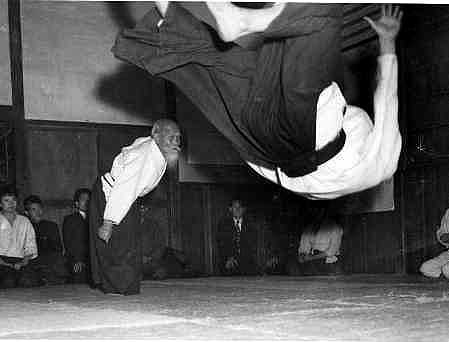
MORIHEI UESHIBA O'SENSEI (December 14,1883-- April 26,1969)
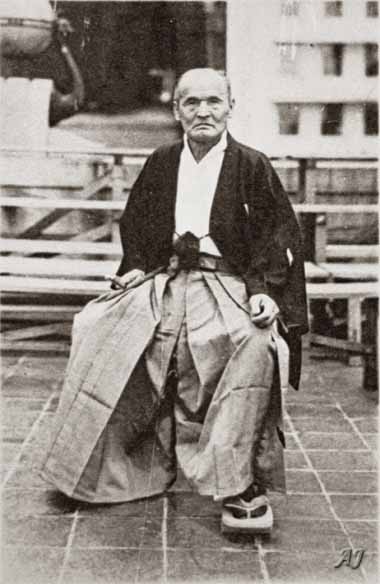
Aikido's founder, Morihei Ueshiba, was born in Japan on December 14, 1883. As a boy, he often saw local thugs beat up his father for political reasons. He set out to make himself strong so that he could take revenge. He devoted himself to hard physical conditioning and eventually to the practice of martial arts, receiving certificates of mastery in several styles of jujitsu, fencing, and spear fighting. In spite of his impressive physical and martial capabilities, however, he felt very dissatisfied. He began delving into religions in hopes of finding a deeper significance to life, all the while continuing to pursue his studies of budo, or the martial arts. By combining his martial training with his religious and political ideologies, he created the modern martial art of Aikido. Ueshiba decided on the name "Aikido" in 1942 (before that he called his martial art "aikibudo" and "aikinomichi").
 On the technical side, Aikido is rooted in several styles of jujitsu (from which modern judo is also derived), in particular daitoryu-(aiki)jujitsu, as well as sword and spear fighting arts. Oversimplifying somewhat, we may say that Aikido takes the joint locks and throws from jujitsu and combines them with the body movements of sword and spear fighting. However, we must also realize that many Aikido techniques are the result of Master Ueshiba's own innovation.
On the technical side, Aikido is rooted in several styles of jujitsu (from which modern judo is also derived), in particular daitoryu-(aiki)jujitsu, as well as sword and spear fighting arts. Oversimplifying somewhat, we may say that Aikido takes the joint locks and throws from jujitsu and combines them with the body movements of sword and spear fighting. However, we must also realize that many Aikido techniques are the result of Master Ueshiba's own innovation.
On the religious side, Ueshiba was a devotee of one of Japan's so-called "new religions," Omotokyo. Omotokyo was (and is) part neo-shintoism, and part socio-political idealism. One goal of omotokyo has been the unification of all humanity in a single "heavenly kingdom on earth" where all religions would be united under the banner of omotokyo. It is impossible sufficiently to understand many of O Sensei's writings and sayings without keeping the influence of Omotokyo firmly in mind.
Despite what many people think or claim, there is no unified philosophy of Aikido. What there is, instead, is a disorganized and only partially coherent collection of religious, ethical, and metaphysical beliefs which are only more or less shared by Aikidoists, and which are either transmitted by word of mouth or found in scattered publications about Aikido.
Some examples: "Aikido is not a way to fight with or defeat enemies; it is a way to reconcile the world and make all human beings one family." "The essence of Aikido is the cultivation of ki [a vital force, internal power, mental/spiritual energy]." "The secret of Aikido is to become one with the universe." "Aikido is primarily a way to achieve physical and psychological self- mastery." "The body is the concrete unification of the physical and spiritual created by the universe." And so forth.
At the core of almost all philosophical interpretations of Aikido, however, we may identify at least two fundamental threads: (1) A commitment to peaceful resolution of conflict whenever possible. (2) A commitment to self-improvement through Aikido training.
Takeda Sokaku Disseminator of DAITO-RYU AIKIJUJUTSU (October 19,1859--April 25,1943).
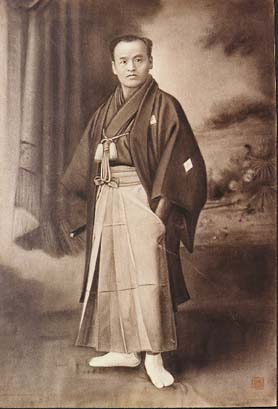
Takeda Sokaku was born the second son of Takeda Sokichi on October 10, 1859 in the Takeda mansion in Oike in Aizu, present-day Fukushima prefecture. As a boy, Sokaku learned kenjutsu, bojutsu, sumo, and Daito-ryu from his father, and studied Ono-ha Itto-ryu at the Yokikan dojo under Shibuya Toba.
In 1873, Sokaku traveled with his father to the dojo of his father's friend, swordsman Sakakibara Kenkichi. There he stayed on as a live-in student and immersed himself in studying the Jikishinkage-ryu. At the Sakakibara dojo Sokaku had opportunities to meet and train with many of the top swordsmen of the day, many of whom had formerly been members of the Tokugawa shogunate's Kobusho, the exclusive martial arts school for government retainers. He studied diligently, and eventually mastered many different skills and weapons including sword (ken), staff (bo), half-bow (hankyu), short-staff (jo), and throwing darts (shuriken). Later he also received a license (inka) in the spear arts of the Hozoin-ryu.
Sokaku traveled around visiting dojos throughout Japan, testing and polishing his martial skills wherever he went. He also deepened his spiritual connections through constant visits for prayer, devotions, and ascetic training to sacred places such as Udomyojin in Kyushu, Mt. Futara in Nikko, and Mt. Haguro in Dewa Province (now Akita and Yamagata prefectures). His sword skills were unparalleled and he was feared as "the Little Tengu of Aizu" (a tengu is a type of long-nosed demon; they are renowned for their martial arts skills).
In about 1875, rumor reached Sokaku that Saigo Takamori had launched his rebellion in Satsuma against the forces of the new Meiji government. He decided immediately that he would go to lend his support. He made it as far as Kyushu but was unable to reach his destination, so he returned to Osaka where he spent the next ten years as a guest in the Kyoshin Meichi-ryu dojo of swordsman Momonoi Shunzo.
Sokaku learned Daito-ryu from his father Sokichi, but it was from Saigo Tanomo, former Chief Councilor of the Aizu domain, that he learned oshikiiuchi. After the Meiji Restoration in 1868, Saigo Tanomo had become a Shinto priest and taken the name Hoshina Chikanori. In 1875 Sokaku visited him at Tsutsukowake Shrine in Fukushima to study for entrance to the priesthood, and while he was there received instruction in the arts of oshikiiuchi from Chikanori. Although Sokaku decided not to become a priest, he visited his mentor many times after that, and under Chikanori's instruction is said to have perfected seemingly miraculous skills of understanding another's mind and thought, and to have grasped the true depths of oshikiiuchi. On May 12th of 1898 Chikanori presented him with a single poem, inscribing it in Sokaku's enrollment book. One interpretation of Chikanori's words is that he is likening the flow of a river to the flow of time. With the beginning of the Meiji period, the age of the sword had ended, and no matter how skilled a swordsman might be, he can no longer make any mark and will amount to nothing. Therefore, it is time to pursue and make your way with jujutsu.
With this, the formal succession of Daito-ryu aiki jujutsu was assured. From that time on Sokaku identified himself as a practitioner of both Daito-ryu aiki jujutsu and Ono-ha Itto-ryu. He traveled around Japan teaching both arts and came to be recognized as the reviver (chuko no so) of the Daito-ryu.
Sokaku was not a large man--he stood no more than 150 centimeters tall--but his eyes were piercing and his techniques were of an almost supernatural level. He is said to have been able to sense a person's past, present, and future even before being introduced. Among his more well-known students were Saigo Tsugumichi, Hokushin Itto-ryu swordsman Shimoe Hidetaro, and aikido founder Ueshiba Morihei, as well as army and navy officers, judges, police, martial artists, and other prominent individuals. He is said to have taught as many as thirty thousand people during his life, the signatures and seals of whom are all entered in enrollment books that are preserved to this day.
In his later years Sokaku focused his activities in Hokkaido. He passed away on April 25, 1943 at the age of eighty-three while teaching in Aomori Prefecture.
Please visit the Home page of Daito- ryu http://www.daito-ryu.org/index.html To learn More of the History of this art.
SOKAKU TAKEDA ( In his Youth)
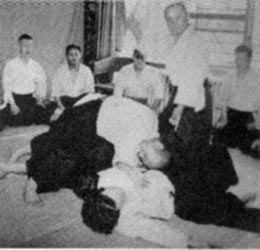
SOKAKU TAKEDA ( In a rare photo showing Daito-ryu)

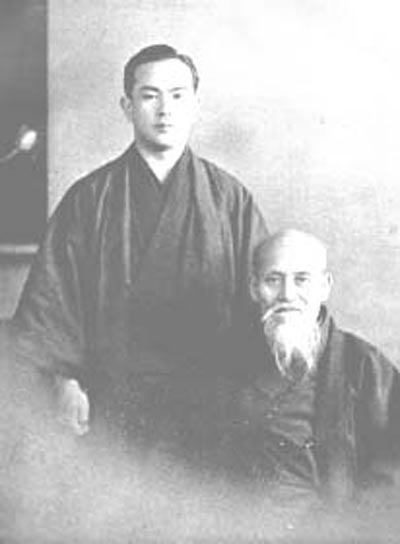
O'Sensei & Koichi Tohei Sensei 10th Dan.
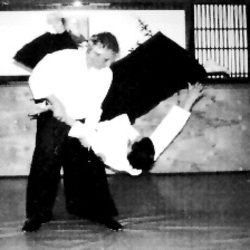
Bill Sosa Sensei Trained Under Koichi Tohei Sensei. I have added a link to the late Bill Sosa Sensei's Site, with a wonderfull interview with Sosa Sensei. This will give You a view of our Aikido Lineage. http://internationalaikido.com/founder/interview.html